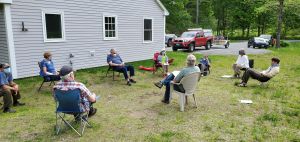- 1-1 What Is a Conservation Commission?
- 1-2 The Purpose of This Handbook
- 1-3 Association of Vermont Conservation Commissions
- Map of Conservation Commissions in VT
1-1 What Is a Conservation Commission?
In 1977, Vermont passed the enabling legislation (24 VS.A. §4501) that allows municipalities to establish conservation commissions. A conservation commission is a citizen advisory board whose purpose is to promote the stewardship of natural and cultural resources in the community. Conservation commissions derive their strength from being an official arm of local government. Thus, they are a recognized and effective way for citizens to accomplish community-based conservation.
A conservation commission is comprised of three to nine members who are appointed by the town’s legislative body. Conservation commissioners serve as volunteers who are organized to speak on behalf of the environment. The state enabling legislation establishes Conservation commissions as advisory, not regulatory, bodies and recommends but does not mandate activities of a commission. Therefore, each conservation commission can tailor its projects and activities to the needs and interests of its municipality and its unique set of natural and cultural resources.
These activities can include both short-term, discrete projects as well as long-term, on-going projects. An important aspect of conservation commissions is that they promote long-term stewardship of their town’s natural and cultural resources for the benefit of present and future generations. A key activity of conservation commissions is often the inventory and study of the natural and cultural resources in town. Activities that flow from inventories include rewrites of sections of the town plan, land conservation projects, and the establishment of local land conservation funds. Commissions also can be instrumental in conserving the working landscapes of their communities by encouraging sustainable agricultural and forestry land uses.
Another important role of conservation commissions is education of local government officials and townspeople about local resources. An environmentally informed citizenry broadens the base of support for stewardship and conservation. Conservation commissions also help communities maintain their sense of place and community. A sense of community and a sense of place are based on local familiarity, rootedness, neighborliness, belonging, and pride. They influence how people relate to and modify their natural and built landscapes. Commissions also work to revive the tradition of community-based activity.
Given the breadth of conservation commissions’ area of concern, it is clear that conservation commissions are more than the sum of their projects. These municipal commissions touch the lives of Vermonters and of future generations by helping to shape and implement a vision for their communities. Each conservation commission leaves a legacy of its stewardship of the natural and cultural resources in town. As of 2021, 120 towns have established conservation commissions or similar committees (see map). That is 44% of Vermont’s 267 municipal entities. (Note: that includes towns as well as villages or cities that plan separately e.g. Enosburgh & Enosburg Falls). These commissions are working at the grassroots level to build and maintain environmentally healthy and sustainable communities.
1-2 The Purpose of This Handbook
Conservation commissioners have been asking for this handbook for many years. Why? Because compiling clear background information in one convenient place helps commissions fulfill their duties and responsibilities and understand their place in town government. It also identifies resources and strategies to help commissions organize themselves, build confidence and support, and conduct their work.
We hope that this handbook will help motivate and inspire present conservation commissioners and will encourage the formation of new commissions in Vermont.
Originally formatted in a loose-leaf binder, this publication has been updated to digital format. The PDF version is hyperlinked & bookmarked. Although the information in this handbook is accurate at the time of publication, laws, regulations, and other information can change. Any person using this handbook should check the current version of statutes, regulations, and other documents for up-to-the-date information.
1-3 Association of Vermont Conservation Commissions
The Association of Vermont Conservation Commissions (AVCC) is a private, nonprofit organization serving the municipal conservation commissions in Vermont. http://vtconserv.powershift.info/ Informally started in 1990, AVCC became a private, nonprofit 501(c)(3) organization registered with the Internal Revenue Service and the State of Vermont in 1996.
AVCC’s mission is to support Vermont’s conservation commissions and to encourage the establishment of more conservation commissions in the state. AVCC is a membership organization, with conservation commissions as well as individuals as members. It is governed by a set of bylaws and overseen by a volunteer board of directors. It has a 9-member board of directors; four Directors are elected by ballot by the membership at an annual meeting and serve three-year terms as volunteers and five Directors are appointed by Vermont Natural Resources Council involving agreements with organizations such as the Agency of Natural Resources or Vermont Land Trust who have some capacity to assist and help cover costs of staff time. These Directors serve five-year terms. Association of Vermont Conservation Commissions became an affiliate of Vermont Natural Resources Council in 2012.
AVCC is supported by membership dues, program and publication revenues, and grants and donations from public and private sources. Revenues are used to support the activities and purposes of AVCC, which include, an annual Conservation Summit, Tiny Grant Program, maintaining the library of Success Stories, listserv, regional trainings & workshops, and serving as a resource for conservation commissions.
Map of Conservation Commissions in VT



